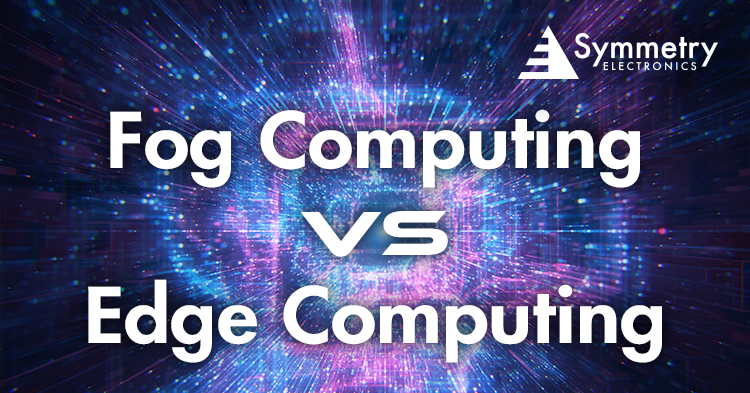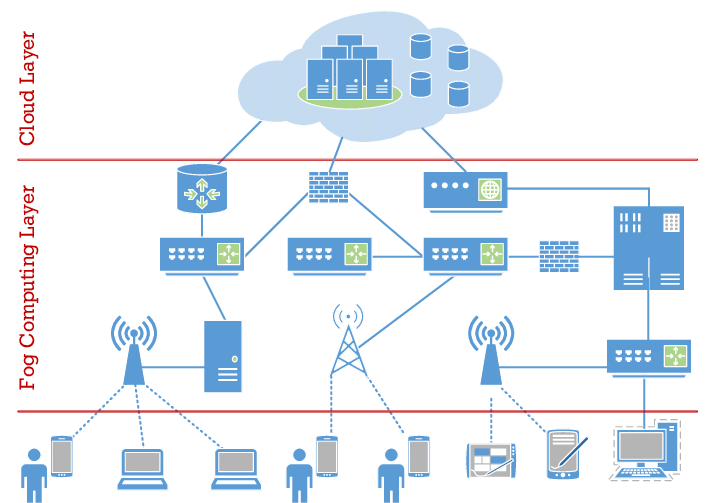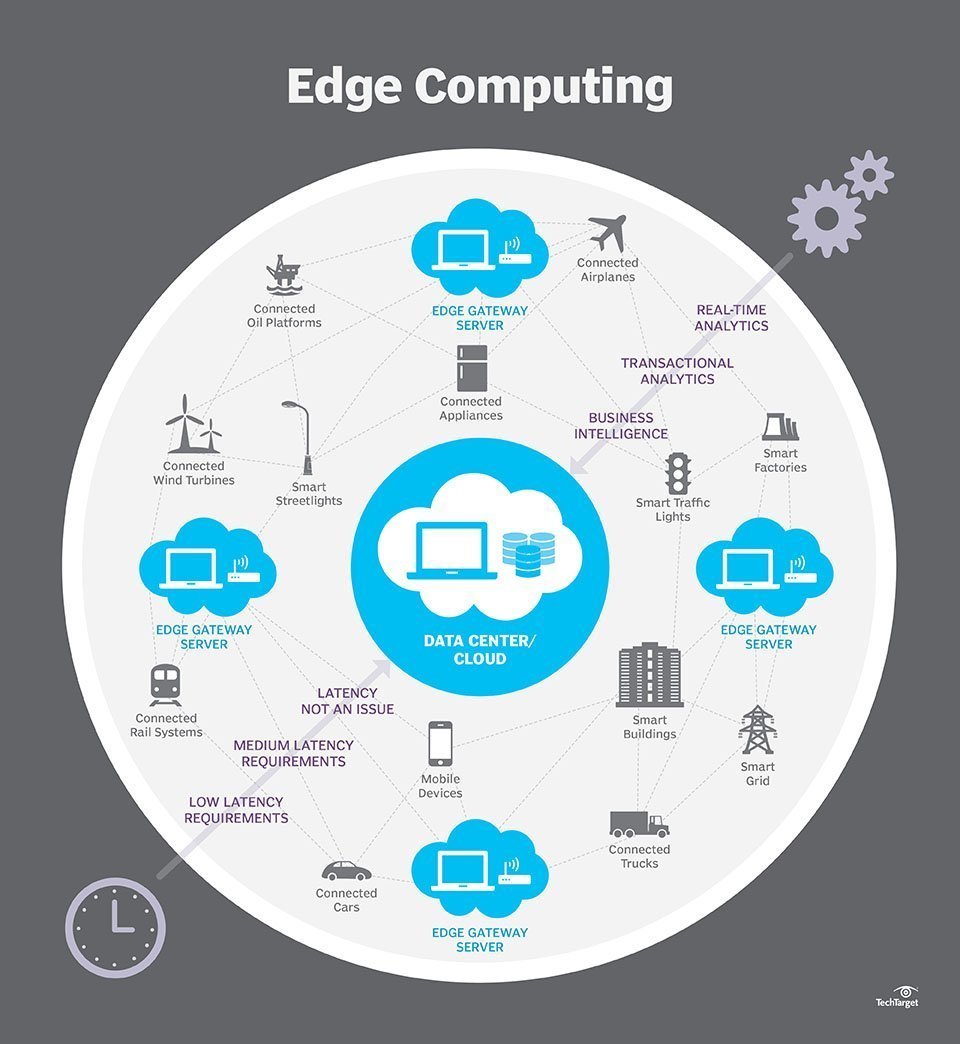- Home
- Braemac Blog
- Fog Computing vs Edge Computing
Fog Computing vs Edge Computing
About Jari Haiston

Fog and edge computing, innovative technologies situated at the outskirts of the cloud ecosystem, hold the potential to revolutionize data processing. Delving into the intricacies of these approaches reveals how they can significantly enhance data processing methods. While both terms are sometimes used interchangeably, it's crucial to understand the nuanced differences that set them apart.
What is Fog Computing?
In the realm of fog computing, a moniker derived from meteorological origins, the focus is on the data territory that exists between the data source and the cloud (Figure 1). Fog architecture places intelligence within the local area network (LAN), enabling data transmission through fog gateways for subsequent processing at the source. When cloud computing struggles to manage the voluminous data generated by internet of things (IoT) and industrial IoT (IIoT) devices, fog computing emerges as a compelling alternative. Its architecture, comprised of interconnected nodes, enables real-time data reception by IoT devices, with latency minimized to a remarkable one-millisecond target.

Figure 1: Fog computing architecture
Source: ResearchGate
The Advantages of Fog Computing:
Fog computing offers a more comprehensive view compared to edge computing due to its multitude of data input points. Some of the key advantages include:
- Bandwidth Efficiency: By limiting data transmission to the cloud, fog computing reduces bandwidth consumption.
- Local Data Processing: Fog computing enables local data processing at intermediary nodes within the network. This can help filter and preprocess data before sending it to the cloud, reducing the load on centralized resources.
- Latency Improvement: Initial data processing at the source minimizes latency times.
- Connectivity Flexibility: Fog computing is adaptable to wired, Wi-Fi, or high-speed 5G networks.
- Distributed Intelligence: Fog computing distributes intelligence across the network, enabling decision-making at various levels. This is especially beneficial for applications like traffic management, where real-time decisions can be made at the local level.
- Reduced Cloud Dependency: Fog computing reduces the need for constant communication with the cloud. This can lead to cost savings by minimizing data transfer costs and cloud service consumption.
Disadvantages of Fog Computing:
While fog computing presents substantial benefits, there are considerations to be aware of:- Location-Based Computing: Fog computing's physical tethering restricts computing to specific locations.
- Security Implications: Potential security threats like IP spoofing and Man in the Middle Attacks could arise.
- Startup Costs: Implementing fog solutions necessitates integration with both edge and cloud systems, potentially posing initial financial barriers.
Despite its introduction by Cisco years ago, there remains some ambiguity around fog computing and its associated vendors.
Fog Computing Use Cases:
With its focus on processing data at a network's edge, fog computing offers numerous use cases across various industries:- Smart Manufacturing and IIoT: In manufacturing environments, fog computing enables real-time analysis of sensor data from production lines and machinery. This assists in optimizing production processes, predictive maintenance, and quality control without relying solely on cloud processing.
- Smart Cities and Urban Infrastructure: Fog computing can enhance the functioning of smart city applications such as intelligent traffic management, street lighting, waste management, and public safety. It enables quicker response times and reduced congestion by processing data from sensors and cameras deployed throughout the city.
- Healthcare and Telemedicine: In healthcare, fog computing aids in remote patient monitoring and diagnostics. It supports wearable devices that can monitor vital signs and transmit data to local fog nodes, allowing healthcare providers to offer real-time insights and interventions.
- Retail and Customer Experience Enhancement: Retailers can utilize fog computing to analyze customer behavior, foot traffic, and inventory levels in real-time. This helps in optimizing store layouts, improving inventory management, and enhancing the overall shopping experience.
- Energy Management and Smart Grids: Fog computing plays a pivotal role in energy management systems by analyzing data from smart meters, sensors, and power grids. It aids in load balancing, fault detection, and energy consumption optimization.
- Transportation and Fleet Management: Fog computing supports connected vehicles by processing data from sensors within cars, buses, and trucks. This assists in vehicle-to-vehicle communication, real-time traffic updates, and improved driver assistance systems.
- Agriculture and Precision Farming: In agriculture, fog computing assists in monitoring soil conditions, weather forecasts, and crop health using sensors. This enables precise irrigation, fertilization, and pest management for improved yield and resource efficiency.
- Logistics and Supply Chain Management: Fog computing can optimize warehouse operations by analyzing data from RFID tags, GPS, and IoT devices. It enhances inventory management, reduces delays, and increases overall supply chain efficiency.
- Oil and Gas Exploration: In remote locations such as oil rigs, fog computing can process data from various sensors to monitor equipment performance, detect anomalies, and ensure the safety of workers.
- Edge AI and Surveillance: Fog computing facilitates real-time analysis of video feeds from security cameras, enabling rapid identification of threats and suspicious activities in critical areas.
- Environmental Monitoring: Fog computing supports environmental monitoring systems by analyzing data from sensors measuring air quality, water levels, and weather conditions. This data aids in disaster preparedness, pollution control, and climate research.
What is Edge Computing?
In contrast to fog computing, edge computing's intelligence (Figure 2) resides at the point of data generation. Edge servers and storage are deployed within devices to collect and process sensor-generated data. Processed data can then be forwarded to data centers for analysis, review, and archival.
Edge computing is decentralized in nature and demands high levels of monitoring and control. Edge offers an effective solution to emerging network problems associated with transmitting large volumes of data that IoT and IIoT corporations produce. However, edge computing does not have the compute and storage that is necessary to perform advanced analytics. While cloud computing can perform advanced analytics, it is too far away from the source to process and respond in a real-time manner.

Figure 2: Edge architecture
Source: Tech Target
Advantages of Edge Computing:
Edge computing offers several advantages that make it a valuable solution for various industries and applications:
- Remote Connectivity: Edge provides flexible connectivity solutions, particularly in remote areas.
- Data Sovereignty Compliance: Keeping data close to its source ensures adherence to data sovereignty regulations.
- Enhanced Security: Data encryption secures information transmitted from the network back to the cloud.
- Local Intelligence: Edge devices can host AI and machine learning models locally, enabling them to make intelligent decisions without constant connectivity to the cloud. This is useful in situations where continuous communication with the cloud is impractical.
- Offline Operation: Edge computing allows devices to continue functioning even when disconnected from the cloud. This is crucial for scenarios where internet connectivity is unreliable or intermittent, ensuring uninterrupted operation.
Disadvantages of Edge Computing:
Edge computing offers numerous benefits, but organizations need to carefully evaluate its challenges and limitations to ensure successful deployment and management of edge-based solutions. It's important to weigh these disadvantages against the specific requirements of the application and environment.- Lack of Centralized Control: Edge computing disperses computing resources, making centralized monitoring and management more complex. This can hinder troubleshooting and overall network visibility.
- Scalability Challenges: Scaling edge deployments can be complex. Adding more devices to the edge network may require careful management and configuration to maintain consistent performance and reliability.
- Network Connectivity Reliability: Edge devices depend on network connectivity for communication and data transfer. Unreliable or intermittent connections can disrupt operations and lead to data loss.
- Complexity of Deployment: Setting up and configuring edge devices requires specialized skills and expertise. Deploying and managing a large number of devices across different locations can be daunting.
Edge Computing Use Cases:
Edge computing has a wide range of use cases across various industries, where processing data closer to its source offers significant advantages in terms of real-time analysis, reduced latency, and efficient resource utilization. Here are some notable use cases:
- IIoT: Edge computing is extensively used in industrial settings for real-time monitoring and control of machinery, optimizing production processes, and enabling predictive maintenance to prevent costly downtime.
- Autonomous Vehicles: Edge computing is crucial for self-driving cars and vehicles, where immediate decision-making based on sensor data is essential to ensure safe navigation and collision avoidance.
- Retail Analytics: Edge computing enhances customer experience by analyzing in-store data from cameras and sensors to optimize store layouts, manage inventory, and provide personalized shopping recommendations.
- Smart Appliances and Home Automation: Edge computing powers smart home devices like thermostats, security cameras, and voice assistants, enabling local processing for quicker response times and enhanced privacy.
- Surveillance and Security: Edge computing processes video feeds from security cameras in real-time, identifying threats and suspicious activities for immediate response.
- Oil and Gas Operations: On oil rigs or remote extraction sites, edge computing monitors equipment performance, detects anomalies, and enhances safety by processing sensor data locally.
- Financial Transactions: Edge computing helps in processing financial transactions and fraud detection in real-time, ensuring secure and efficient payment processing.
- Manufacturing and Quality Control: Edge computing analyzes data from sensors on production lines, ensuring quality control, minimizing defects, and optimizing manufacturing processes.
- Smart Wearables: Edge computing enhances the capabilities of wearable devices like fitness trackers and smartwatches by processing data locally, providing immediate feedback to users.
- Edge AI in Edge Devices: Edge computing facilitates local AI processing for applications like image recognition, natural language processing, and machine learning on devices like smartphones and cameras.
- Remote Locations and Harsh Environments: Edge computing supports operations in remote or harsh environments, such as mining sites, oil rigs, and offshore platforms, where network connectivity is limited.
Interested in incorporating cloud, edge, or fog computing into your data processing logistics? Contact Symmetry Electronics today!
